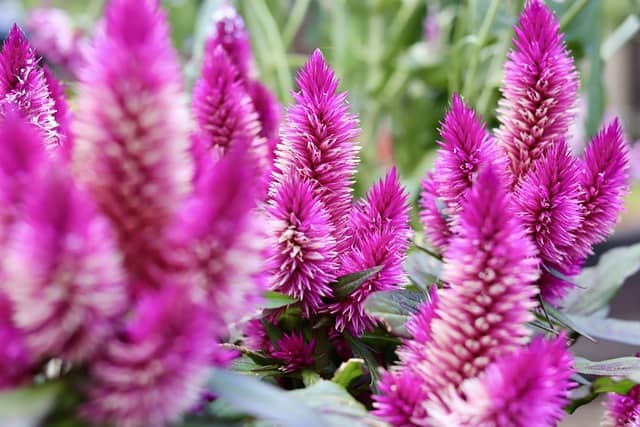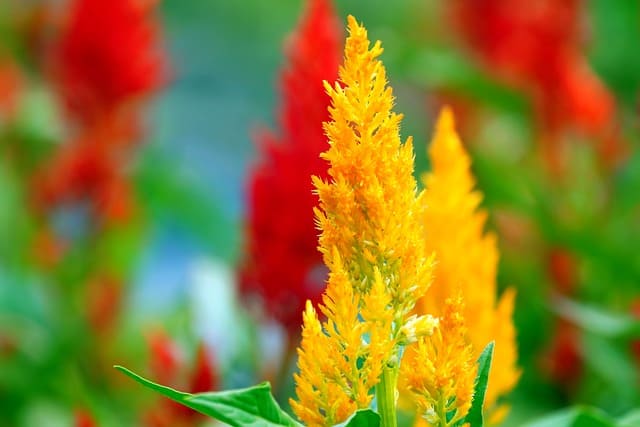Part of what makes flowers look consistently beautiful is maintaining their appearance. Celosias are an especially magnificent flower, blooming into colorful marvels that look like flames or even tall stalks of colorful wheat. It’s good to know how to deadhead celosia so your flowers grow to their potential.
Deadheading celosias is also a great way to prolong their blooming season and keep your garden looking vibrant and colorful. The process of deadheading your celosia, while it sounds grim, is actually a very important part of maintaining the health of your flowers. Deadheading makes sure that buds that still have potential to bloom into healthy flowers get the chance to grow.
You’ll have to remove any flowers past their prime, which needs to be done carefully to avoid harming your celosia.
There are only a few important tips that are necessary to deadhead a celosia successfully without cutting off too much of a healthy portion of the plant. For most varieties of celosias, deadheading can be an excellent way to keep plants healthy, even when they go dormant for the winter.
How To Deadhead Celosia

The celosia is an annual flower, meaning they tend to blossom in the spring and summer and continue to stay vibrant in the fall, then eventually die off in the winter.
With proper care, your celosia will grow back as the frost melts away and spring comes again. Deadheading is one way to care for your celosia to keep the overall structure of the plant healthy.
The process of deadheading might sound more complicated than it actually is. Essentially, you’re taking off any of the dead flowers attached to the stems of your plant so they don’t end up depleting your plant’s overall resources.
Additionally, dead flowers don’t look nice, and can end up making your garden or plant setup look unpleasant, eventually littering them with dead petals. Even when flowers have died, your plant is still going to push energy, resources, and water to that flower in an effort to keep seeds developing.
Plants like to propagate as much as possible, but since the flower is dead, those seeds aren’t going to bloom unless they manage to spread through your garden by wind. If you deadhead those flowers, energy will go into creating new buds that turn into flowers instead.
Furthermore, deadheading your celosia is going to help the process of new flowers blooming. This is because it initiates your plant’s natural process of making fresh, new seeds that will grow into more beautiful celosias.
Without deadheading at the appropriate time, current seeds will just end up wasting away along with the dead flower.
1. Clean Your Scissors First

Since you likely don’t have a pair of gardening scissors for each of your plants, cleaning and sterilizing your gardening shears or scissors is a necessary – and often overlooked – part of any pruning or deadheading of your celosias, among other plants.
This ensures that no cross-contamination occurs, which can end up harming some of your plants.
To clean your scissors in preparation for deadheading, you’ll want to use some isopropyl alcohol and clean the blades thoroughly. You should then set your scissors out to dry completely before you begin the deadheading process.
2. Deadhead Flowers From The Stem
You want to get a very fine, sharp set of gardening scissors to ensure you can get as accurate of a cut as possible. Celosia flowers are usually very small, so you want to have a steady hand so you don’t cut off more than you intend to.
For best results, aim to cut the dead flower right at the intersection of the flower’s stem and the main stem of the plant. This is your best chance at encouraging a fresh new flower to grow from that area.
If you find that using scissors is too difficult, you can use clean fingers to gently pinch the flower off of its stem and pull it off.
3. Try To Salvage Leaves And Stems

When you’re searching through your celosia to deadhead any withering buds or flowers, see if you can salvage the healthy leaves. The same is true with the main stem of the flower.
If you can’t, it’s not going to mean dire consequences for your celosia; it just means a new flower may not have the opportunity to bloom in that specific spot.
4. Start Deadheading Your Celosias Early
Even though your celosia will continue to add beauty to your space from spring to fall, you don’t want to start deadheading the flower too early or too late in its growing season. Once the year approaches late spring, you can start searching through your celosias to take off any dead flowers.
Deadheading isn’t usually a one-and-done process either, especially if you’re interested in having new flowers bloom in place of dead ones to keep your plant as lush as possible.
You’ll want to inspect your celosia at least once a week or so, during your regular care, so you can deadhead in short intervals instead of having to do it all at once.
Once fall comes, there really isn’t any need to go through this process. It’s best to leave your celosia alone at this point and wait until the following spring to see the condition of your celosia’s flowers.
Read a previous post: Snake Plant Mushy Leaves
Summary
Celosias are very elegant, beautiful flowers that bloom into some of the most gorgeous plants in a garden, and are easy to care for. That said, deadheading is an important process in keeping these flowers vibrant and lively.
Knowing how to deadhead celosia will ensure you don’t end up damaging your plant, and give it the opportunity to flourish for as long as possible.
Frequently Asked Questions
Do You Have To Deadhead Celosia?
It’s recommended that you deadhead your celosia in the spring and summer so that you see new flowers bloom. If you don’t, or you wait too long, your celosia will start to grow seeds rather than bloom new flowers.
The flower doesn’t have enough energy for both. Deadheading can also make sure new flowers bloom next season.
There are numerous types of celosias, however, and not all of them need to be deadheaded. Be sure you can identify the celosia you’ve planted before you decide to start cutting off flowers. One example of a celosia that doesn’t require deadheading is the modern feather celosia.
How Do I Prune Celosia?
You can use both pinching and deadheading to make sure that your celosia plant always looks healthy and attractive. Pinching any tips of the plant before flowers bloom will encourage your celosia to grow more lush.
Taking off dead flowers and leaves through deadheading will also make sure your celosia always stays healthy.
Is Pinching The Same As Deadheading?
Pinching and deadheading are two different plant maintenance procedures that accomplish different things. When you pinch a plant, you are simply taking the tip off in an effort to encourage more substantial growth.
When you deadhead a plant, you are removing any dead elements to avoid having the plant spend energy on dead flowers.
That said, when it comes to celosias specifically, you can use the pinching method to remove some dead flowers in some cases. It’s mainly going to depend on the type of celosia you have in your garden or in your home.

Hey, I’m Lisa and I’ve been an avid gardener for over 30 years. I love writing, talking and living in the garden! Feel free to connect with me on my socials below


